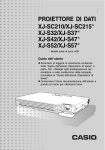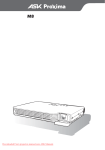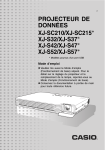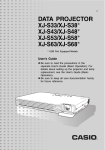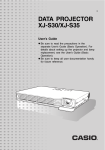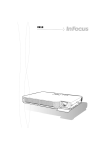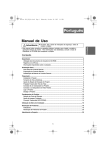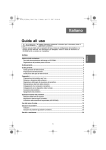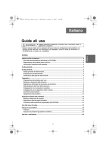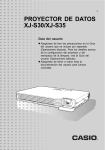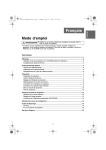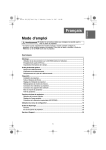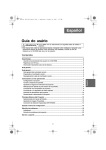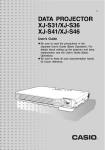Download Casio XJ-57 User`s guide
Transcript
E DATA PROJECTOR XJ-SC210/XJ-SC215* XJ-S32/XJ-S37* XJ-S42/XJ-S47* XJ-S52/XJ-S57* * USB Port Equipped Models User’s Guide z Be sure to read the precautions in the separate User’s Guide (Basic Operation). For details about setting up the projector and lamp replacement, see the User’s Guide (Basic Operation). z Be sure to keep all user documentation handy for future reference. Downloaded From projector-manual.com Casio Manuals • DLP is a registered trademark of Texas Instruments of the United States. • Microsoft, Windows, and Windows Vista are registered trademarks or trademarks of Microsoft Corporation in the United States and other countries. • Other company and product names may be registered product names or trademarks of their respective owners. • The contents of this User’s Guide are subject to change without notice. • Copying of this manual, either in part or its entirety is forbidden. You are allowed to use this manual for your own personal use. Any other use is forbidden without the permission of CASIO COMPUTER CO., LTD. • CASIO COMPUTER CO., LTD. shall not be held liable for any lost profits or claims from third parties arising out of the use of this product or this manual. • CASIO COMPUTER CO., LTD. shall not be held liable for any loss or lost profits due to loss of data due to malfunction or maintenance of this product, or any other reason. • The sample screens shown in this manual are for illustrative purposes only, and may not be exactly the same as the screens actually produced by the product. Downloaded From projector-manual.com Casio Manuals 2 Contents About this manual... .......................................................................................... 4 USB Port Equipped Model Users................................................................................. 4 Operation During Projection .......................................... 5 Image Operations During Projection ................................................................. 5 Adjusting Image Brightness ......................................................................................... 5 Selecting the Color Mode............................................................................................. 6 Zooming an Image ....................................................................................................... 6 Momentarily Cutting Off the Input Source Image ......................................................... 7 Freezing an Image ....................................................................................................... 7 Displaying a Pointer in the Projected Image ................................................................ 8 Changing the aspect ratio of the projected image ....................................................... 9 Eco Mode ........................................................................................................ 10 Using the [FUNC] Key..................................................................................... 10 Configuring Advanced Projector Settings.................. 11 Basic Setup Menu Operations ........................................................................ 11 Displaying the Setup Menu ........................................................................................ 11 Configuring Setup Menu Settings .............................................................................. 11 Basic Setup Menu Example ....................................................................................... 12 Password Protecting the Projector.................................................................. 14 Inputting a Password ................................................................................................. 14 Using the Password Feature...................................................................................... 14 Entering the Password when Turning On the Projector ............................................. 16 Restoring Projector Settings to Their Initial Factory Defaults.......................... 17 Setup Menu Contents ..................................................................................... 18 Image Adjustment 1 Main Menu ................................................................................ 19 Image Adjustment 2 Main Menu ................................................................................ 20 Volume Adjustment Main Menu ................................................................................. 21 Screen Settings Main Menu ....................................................................................... 22 Input Settings Main Menu .......................................................................................... 24 Option Settings 1 Main Menu..................................................................................... 25 Option Settings 2 Main Menu..................................................................................... 26 USB Settings Main Menu Items (USB Port Equipped Models Only).......................... 28 Operational Info Main Menu....................................................................................... 28 Restore All Defaults Main Menu................................................................................. 29 Downloaded From projector-manual.com Casio Manuals 3 Appendix........................................................................ 30 Remote Controller Signal Range .................................................................... 30 Projection Distance and Screen Size.............................................................. 31 Aspect Ratio Setting and Projection Image during RGB Input........................ 32 Supported Signals........................................................................................... 33 About this manual... z This manual assumes that you are already familiar with the contents of the separate “User’s Guide (Basic Operation)”. z All of the operations in this manual are explained using the remote controller that comes with the projector. The following key operations can also be performed on the projector instead of the remote controller: [MENU], [S], [T], [X], [W], [ENTER], [ESC], [ ], [INPUT], [AUTO], [ZOOM +], [ZOOM –], [FOCUS S], [FOCUS T]. To perform this remote controller operation: Use this projector button: [ENTER] Button in the center of the cursor keys [ZOOM +], [ZOOM –] [ZOOM] button in combination with the [X] and [W] (or [S] and [T]) buttons [FOCUS S], [FOCUS T] [FOCUS] button in combination with the [S] and [T] (or [X] and [W]) buttons USB Port Equipped Model Users This manual does not include information about using the XJ-SC215/XJ-S37/XJ-S47/XJ-S57 model projector while a USB device is connected to its USB port. For details about connecting USB devices to the projector and procedures you need to perform to project images from a USB device, see “USB Function Guide” on the bundled CD-ROM. Downloaded From projector-manual.com Casio Manuals 4 Operation During Projection This section explains the various types of operations you can perform while the projector is projecting an image. Image Operations During Projection You can perform the following operations while projecting an image. z Image brightness adjustment z Color mode selection z Image zooming z Momentary cut off of the input source image and projection of a black or blue screen, or a logo z Image freeze z Pointer display in the projected image z Aspect ratio switching Adjusting Image Brightness Note (for USB port equipped model users) Use the setup menu (page 11) to adjust image brightness when you have an external device connected to the projector’s USB port. To adjust image brightness 1 Press the [BRIGHT] key. 2 3 Use the [W] and [X] keys to adjust image brightness. z This displays the brightness adjustment window. To hide the window, press the [ESC] key. Downloaded From projector-manual.com Casio Manuals 5 Selecting the Color Mode You can select from among five different color mode settings to optimize the projected image in accordance with image contents and projection conditions. To change the color mode 1 Press the [COLOR MODE] key. 2 Use the [T] and [S] keys to move the highlighting to the color mode you want to select, and then press the [ENTER] key. z This displays the color mode selection window. The currently selected color mode is the one whose button is selected (filled in). z This will select the button next to the highlighted color mode name. z For details on what each color mode does, see “Color Mode” under “Image Adjustment 1 Main Menu” on page 19. 3 To hide the window, press the [ESC] key. Zooming an Image 1 Press the [D-ZOOM +] key. 2 To zoom in on the center of the projected image more, press the [D-ZOOM +] key again. To zoom out, press the [D-ZOOM –] key. z This will enlarge the center of the projected image one step. z Each press of [D-ZOOM +] zooms in (increases the zoom factor), while [D-ZOOM –] zooms out. Holding down either key continuously scrolls the zoom factor. 3 While an image is zoomed, use [S], [T], [W], and [X] to scroll the view to other parts of the image. 4 To exit the zoom operation, press the [ESC] key. Downloaded From projector-manual.com Casio Manuals 6 Momentarily Cutting Off the Input Source Image 1 Press the [BLANK] key. 2 To resume projection of the image from the input source, press the [BLANK] key (or [ESC] key). z This temporarily cuts off the image from the input source and projects a black screen in its place. Note You can specify projection of a black screen or blue screen, or a logo. For details, see “Blank Screen” under “Screen Settings Main Menu” on page 23. Freezing an Image Pressing the [FREEZE] key freezes the projected image. To freeze the projected image 1 While an image is being projected from an input source, press the [FREEZE] key. z This will capture the image that is on the screen at the moment you press [FREEZE] and stores it in projector memory. That image remains projected on the screen. 2 To restore projection of the image from an input source, press the [ESC] key. Downloaded From projector-manual.com Casio Manuals 7 Displaying a Pointer in the Projected Image You can select from among different pointer styles, including various arrow styles, for display in the projected image. Pointers can be used during a presentation to indicate or highlight a specific part of the image. Note Depending on the pointer style you are using, the pointer may not display properly when you are using keystone correction. If this happens, use the [KEYSTONE +] and [KEYSTONE –] keys to change the keystone correction value to zero. To display a pointer in the image 1 Press the [POINTER] key. 2 Use the cursor keys to move the pointer to the location you want. 3 To modify the pointer as described below, press the [STYLE] key. z This will cause a pointer to appear in the image. z You also can use the setup menu to specify the pointer type that appears first when you press the [POINTER] key. For details, see “Pointer” under “Option Settings 2 Main Menu” on page 26. z Holding down a cursor key moves the cursor at high speed. For this pointer type: Pressing [STYLE] will change it like this: J J J J J J J J J J J J Toggle between flashing and not flashing Downloaded From projector-manual.com Casio Manuals 8 To select the pointer type 1 2 Press the [POINTER] key to display the pointer. Keep pressing the [POINTER] key until the pointer you want is displayed. z Each press of the [POINTER] key cycles through the available pointer types. To clear the pointer from the image Press the [ESC] key. Changing the aspect ratio of the projected image Press the [ASPECT] key to change the aspect ratio of the projected image. How the aspect ratio changes depends on the current input source. Input Source Pressing [ASPECT] will do this: VIDEO or component Toggles the aspect ratio of the image between 4:3 and 16:9. When the input source is a component signal with an aspect ratio of 16:9, the projection aspect ratio also will become 16:9 automatically and pressing the [ASPECT] key will not change it. RGB Toggles the aspect ratio of the image between 4:3 and “Maintain”. Selecting 4:3 will project with an aspect ratio of 4:3, regardless of the input source aspect ratio. Selecting “Maintain” will project while maintaining the aspect ratio of the input source. Note z For details about how the aspect ratio setting affects the projected image when the input source is RGB, see “Aspect Ratio Setting and Projection Image during RGB Input” (page 32). z You also can change the aspect ratio setting using the setup menu. For details, see “Aspect Ratio” under “Screen Settings Main Menu” on page 22. Important! Note that enlarging or reducing the size of an image using the [ASPECT] key for commercial purposes or public presentation may infringe on the legally protected copyright of the copyright holder of the original material. Downloaded From projector-manual.com Casio Manuals 9 Eco Mode Turning on the Eco Mode reduces lamp brightness to save power. The projector’s cooling fan also operates at a slower speed while the Eco Mode is turned on, which results in quieter operation. Turn on the Eco Mode when your priority is quieter operation. Turn off the Eco Mode when your priority is maximum brightness. To turn the Eco Mode on or off Press [ECO] to toggle the Eco Mode on and off. Note (for USB port equipped model users) Use the setup menu (page 11) to select the lamp mode when you have an external device connected to the projector’s USB port. Using the [FUNC] Key Pressing the [FUNC] key displays the menu shown below. You can use this menu to perform the operations described below. z Adjust image brightness Highlight “Brightness” and then press the [ENTER] key. • This performs the same operation as pressing the [BRIGHT] key ( key) described on page 5. z Turn the Eco Mode on or off Highlight “Eco Mode” and then press the [ENTER] key. • This performs the same operation as pressing the [ECO] key (U key) described on page 10. z Select the aspect ratio of the projected image Highlight “Aspect Ratio” and then press the [ENTER] key. • This performs the same operation as pressing the [ASPECT] key ( key) described on page 9. Note (for USB port equipped model users) When you have an external device connected to the projector’s USB port, use the [FUNC], [ ], [U], and [ ] keys to control the connected device. For details, see the “USB Function Guide” on the bundled CD-ROM. Downloaded From projector-manual.com Casio Manuals 10 Configuring Advanced Projector Settings Your projector has a setup menu that you can use to configure advanced settings. Basic Setup Menu Operations Displaying the Setup Menu Pressing the [MENU] key displays the menu shown below in the center of the projection screen. Main menu The main menu includes nine (10 on the USB port equipped models) main menu items. The currently selected main menu item is the one that is highlighted. Sub-menu The sub-menu shows each individual setting under each main menu item, and its current setting. Guidance text Guidance text provides a brief description of the main key operations available for the operation you are currently performing. To exit the setup menu Press the [MENU] key. Configuring Setup Menu Settings 1 2 3 4 Press the [MENU] key to display the setup menu. Use the [T] and [S] keys to select the main menu item you want by highlighting it. Press the [ENTER] key. Use the [T] and [S] keys to select the sub-menu item you want by highlighting it. 5 Perform the required operation on the selected sub-menu item screen. 6 7 To return to the main menu from the sub-menu, press the [ESC] key. z The guidance text explains the operations you need to perform to configure each setting. To exit the setup menu, press the [MENU] key. Downloaded From projector-manual.com Casio Manuals 11 Basic Setup Menu Example The procedure below shows how to configure the following three settings: • Image Adjustment 1 J Contrast • Image Adjustment 1 J Color Mode • Option Settings 1 J Eco Mode Note z Certain settings on the setup menu cannot be changed while there is no input signal to the projector. Because of this, you should configure setup menu settings after selecting an input source and starting projection. z This example covers basic steps only. For more detailed information, see “Setup Menu Contents” on page 18. To configure the “Image Adjustment 1 J Contrast” setting 1 2 Press the [MENU] key to display the setup menu. 3 Press the [T] key once to select “Contrast”. 4 Use the [W] (lighter) and [X] (darker) keys to adjust contrast. “Image Adjustment 1” is initially selected on the main menu, so simply press the [ENTER] key. Downloaded From projector-manual.com Casio Manuals 12 To configure the “Image Adjustment 1 J Color Mode” setting 5 6 Press the [T] key once to select “Color Mode”. 7 Use the [T] and [S] keys to select the color mode you want, and then press the [ENTER] key. 8 After selecting the color mode you want, press the [ESC] key. Press the [ENTER] key. z This displays the color mode menu. To configure the “Option Settings 1 J Eco Mode” setting 9 Press the [ESC] key. 10 Press the [T] key five times to select “Option Settings 1”. 11 Press the [ENTER] key. 12 Press the [T] key two times to select “Eco Mode”. 13 Use the [W] and [X] keys to select “On” or “Off”. 14 After you are finished, press the [MENU] key to exit the setup menu. Downloaded From projector-manual.com Casio Manuals 13 Password Protecting the Projector The password feature lets you keep unauthorized individuals from using the projector. You can specify whether password input is required whenever you turn on the projector, and you can specify and change the password as required. Use the setup menu “Option Settings 1 J Power On Password” setting to configure power on password settings. Inputting a Password The password of your projector is not really a “word” made up of letters, but rather a sequence of remote controller key inputs. The following is the 8-key sequence that represents the initial factory default password. [INPUT][AUTO][BLANK][FREEZE][S][T][W][X] Using the Password Feature Note the following precautions whenever you use the password feature. • The password feature protects against unauthorized use of the projector. Note that it is not an anti-theft measure. • You will need to enter the initial factory default password the first time you use the projector after turning on the password feature. Change the initial factory default password to a different one of your choice as soon as possible after turning on the password feature. • Remember that password operations are always performed using the remote controller, so you should take care not to lose or misplace the remote controller. • Also note that you will not be able to input the password if the remote controller battery is dead. Replace the remote control battery as soon as possible after it starts to go low. If you forget your password... You will not be able to use the projector if you forget the password for some reason. If you forget the password, you will need to bring the following two items to your CASIO distributor to have the password cleared. Note that you will be charged to have the password cleared. 1. Personal identification (original or copy of you driver’s license, employee I.D., etc.) 2. Projector unit Note that your CASIO distributor will not be able to clear the password of your projector unless you bring both of the items listed above. Also, keep the projector’s warranty in a safe place. Important! Having your password cleared using the procedure described above will return all of the settings of your projector, except for the lamp time, to their initial factory defaults. Downloaded From projector-manual.com Casio Manuals 14 Keep a written record of your password! You will not be able to use the projector if you forget its password. We strongly suggest that you keep a written or other type of record of the password so you can look it up when necessary. To change the password 1 2 3 Press the [MENU] key to display the setup menu. Use the [T] key to select “Option Settings 1”, and then press the [ENTER] key. Use the [T] key to select “Power On Password”, and then press the [ENTER] key. z This will display a dialog box prompting you to enter the current password. 4 Enter the current password. z If the projector is still protected by the factory default password, perform the key operation shown below to enter it. [INPUT][AUTO][BLANK][FREEZE][S][T][W][X] 5 After entering the current password, press the [ENTER] key. 6 Use the [T] key to select “Change Password”, and then press the [ENTER] key. 7 Enter a key sequence up to eight key operations long. 8 After entering the new password, press the [ENTER] key. 9 Re-enter the same password key sequence you entered in step 7 and then press [ENTER]. z This displays the Power On Password setting screen. z This will display a dialog box prompting you to enter the new password. z You can use any of the following keys as part of your password key sequence. [INPUT], [AUTO], [BLANK], [FREEZE], [VOLUME], [COLOR MODE], [D-ZOOM +], [D-ZOOM –], [KEYSTONE +], [KEYSTONE –], [MENU], [POINTER], [ ], [U], [ ], [S], [T], [W], [X], [FUNC] z This will display a dialog box prompting you to enter the same password again. z The message “Your new password has been registered.” indicates that the password has been changed. Press the [ESC] key. z If the password you entered in this step is different from the one you entered in step 7, the message “The password you input is wrong.” appears. Press the [ESC] key to return to step 7. Downloaded From projector-manual.com Casio Manuals 15 To turn password protection on and off 1 Display the Power On Password setting screen by performing steps 1 through 5 of the procedure under “To change the password” on page 15. z At this time, make sure that “Power On Password” is selected on the Power On Password setting screen. 2 Use the [W] and [X] keys to select “On” or “Off”. z Changing the power on password setting from “On” to “Off” causes the confirmation dialog box shown below to appear. Press the [ENTER] key to confirm that you want to turn on power on password protection, or [ESC] to exit the dialog box without doing anything. 3 After you are finished, press the [MENU] key to exit the setup menu. Entering the Password when Turning On the Projector When you turn on the projector while password protection is turned on will cause a password input dialog box to appear on the projection screen. All projector operations will be accessible to you after you input the correct password and press the [ENTER] key. Note You can perform the projection size adjustment operation ([ZOOM +] / [ZOOM –] keys), focus operation ([FOCUS S] / [FOCUS T] keys), and power off operation ([ ] key) while the password input dialog box is on the projection screen. Downloaded From projector-manual.com Casio Manuals 16 Restoring Projector Settings to Their Initial Factory Defaults You can use the procedures in this section to restore all of the settings on a particular main menu or all of the settings on the setup menu to their initial factory defaults. To restore all settings on a particular main menu to their initial factory defaults 1 2 Press the [MENU] key to display the setup menu. Use the [T] and [S] keys to select the main menu whose settings you want to restore to their initial factory defaults. z You can select Image Adjustment 1, Image Adjustment 2, Volume Adjustment, Screen Settings, Input Settings, Option Settings 1, or Option Settings 2. 3 4 5 Press the [ENTER] key. 6 7 Use the [S] key to select “Yes”. Use the [T] key to select “Restore Menu Defaults”. Press the [ENTER] key. z This will display a confirmation screen like the screen shown below. To restore the settings of the main menu to their initial defaults, press the [ENTER] key. z To exit the operation without doing anything, press [ESC] instead of [ENTER]. 8 After you are finished, press the [MENU] key to exit the setup menu. Note z The language setting and the password are not returned to their initial factory defaults if you select Option Settings 1 in step 2. z For details about how the above procedure initializes settings, see the explanations of the settings under “Setup Menu Contents” on page 18. Downloaded From projector-manual.com Casio Manuals 17 To restore all settings on the setup menu to their initial factory defaults 1 2 Press the [MENU] key to display the setup menu. 3 Use the [T] key to select “Restore All Defaults” sub-menu, and then press the [ENTER] key. Use the [T] key to select “Restore All Defaults”, and then press the [ENTER] key. z This displays a confirmation message asking if you want to initialize all settings. 4 5 Use the [S] key to select “Yes”. To restore all settings on the setup menu to their initial defaults, press the [ENTER] key. z This will restore all of the settings to their initial factory defaults, except for the Language, Lamp Time, and password settings. z To exit the operation without doing anything, press [ESC] instead of [ENTER]. 6 After you are finished, press the [MENU] key to exit the setup menu. Setup Menu Contents This section contains tables that provide detailed explanations of all of the items included on the setup menu. The following describes the type of information that appears in each of the columns of the tables. Setting Name This column shows the names of the settings as they appear on the sub-menu. Input This column shows the input source for which each setting is supported. Input source names are abbreviated as R (RGB input), C (component video input), V (video input), and U (USB input, USB port equipped models only). The letter N indicates that the setting can be configured while there is no input signal. Setting Unit The setting unit indicates how a setting is stored. “Source Specific” in this column indicates that separate settings can be stored for each individual input source. For example, you could store an “Image Adjustment 1 J Brightness” setting of –1 for RGB input and a setting of +1 for VIDEO input. “Single” in this column indicates that a single setting is stored and applied, regardless of the input source. Description This column provides details about the setting item and how to select it. The initial default setting is indicated by an asterisk (*). Downloaded From projector-manual.com Casio Manuals 18 Image Adjustment 1 Main Menu Setting Name Input Setting Unit Description Brightness RCVU Source Specific Use this sub-menu to adjust the brightness of the projected image. A larger value produces a brighter image. Contrast RCVU Source Specific Use this sub-menu to adjust the contrast of the projected image. A larger value produces a stronger contrast. Sharpness RCV Source Specific Use this sub-menu to adjust the sharpness of the outlines in the projected image. A larger value makes the image sharper, while a smaller value makes it softer. Saturation RCV Source Specific Use this sub-menu to adjust the color saturation of the projected image. A larger value increases color saturation. Tint RCV Source Specific Use this sub-menu to adjust the tint of the projected image. A larger value makes the overall image more bluish, while a smaller value makes the overall image more reddish. This setting is supported only when the signal is NTSC or NTSC4.43. Color Mode RCVU Source Specific You can select from among five different color mode settings to optimize the projected image in accordance with image contents and projection conditions. Presentation: Use this setting for standard presentations in a well-lit area. Standard: Use this setting when you want to highlight the colors of your presentation. Graphics: Use this setting when you want photographs and graphics to appear natural. Theater: Use this setting to bring out the dark portions of your images. Blackboard: Use this setting for easy viewing when projecting onto a blackboard. Color Balance RCVU Source Specific This sub-menu lets you adjust the color balance of the projected image. Preset: You can select from among three preset color balance settings: Warm, Normal,* Cold. Color: You can adjust the intensity of red, green, and blue within the range of –50 to +50. The intensity of a color increases along with the setting value. Color settings can be adjusted individually only when “Normal” is selected as the “Preset” setting. Downloaded From projector-manual.com Casio Manuals 19 Setting Name Input Setting Unit Description Noise Filter RCV Source Specific This setting is valid when VIDEO is selected as the input source. Normal*: Select this setting when projecting a movie. High: Select this setting when projecting still images. In particular, this setting should be used when projecting still images from a digital camera connected to the projector’s VIDEO terminal. Restore Menu Defaults RCVU Source Specific Use this sub-menu to return all of the sub-menu items on the Image Adjustment 1 main menu to their initial default settings. z Restoring menu defaults when there is no input signal will restore defaults for the currently selected input source. Image Adjustment 2 Main Menu Setting Name Input Setting Unit Description Vertical Position RCV Signal Specific Use this sub-menu to adjust the vertical position of the input source image within the projection area. Horizontal Position RCV Signal Specific Use this sub-menu to adjust the horizontal position of the input source image within the projection area. Frequency R Signal Specific When vertical bands appear in the projected image while RGB is selected as the input source, it means that the frequency setting is not correct. When this happens, use this setting to adjust the frequency manually. Important! If, for some reason, your manual frequency settings cause the image input from the computer to disappear from the projection, you can press the [AUTO] key to perform an auto adjust operation, which should cause the image to appear. Phase R Signal Specific When there is flickering in the projected image while RGB is selected as the input source, it means that the phase setting is not correct. When this happens, use this setting to adjust the phase manually. Downloaded From projector-manual.com Casio Manuals 20 Setting Name Restore Menu Defaults Input RCV Setting Unit Source Specific Description Use this sub-menu to return all of the sub-menu items on the Image Adjustment 2 main menu to their initial default settings. z Restoring menu defaults when there is no input signal will restore defaults for the currently selected input source. z “Image Adjustment 2” main menu “Vertical Position”, “Horizontal Position”, “Frequency”, and “Phase” defaults can be restored for the current signal type (XGA/60Hz, SXGA/60Hz,etc.) only. About the “Signal Specific” Setting Unit For the items that have “Signal Specific” in the “Setting Unit” column of the above table, the setting is saved for the specific type of signal (XGA/60Hz, SXGA/60Hz, etc.) that is being input when the setting is performed, and not for a specific input source. Volume Adjustment Main Menu Setting Name Input Setting Unit Description Volume RCVUN Source Specific Use this sub-menu to adjust the volume level of the projector’s speaker. z Changing this setting when there is no input signal changes the volume setting of the currently selected signal source. Restore Menu Defaults RCVUN Source Specific Use this sub-menu to return Volume to its initial default setting. z Restoring menu defaults when there is no input signal will restore defaults for the currently selected input source. Downloaded From projector-manual.com Casio Manuals 21 Screen Settings Main Menu Setting Name Input Setting Unit Description Keystone Correction RCVUN Single Use this sub-menu to correct vertical keystoning of the projected image. Aspect Ratio RCV Source Specific Use this sub-menu to select an aspect ratio setting for the projected image. 4:3*: Projects with an aspect ratio of 4:3. This is the initial default setting when the input source is either video or component video. 16:9 (VIDEO or component input source only): Projects with an aspect ratio of 16:9 (movie, Hi-Vision, etc.) Selecting this option when projecting a video movie from an input source that has been squeezed from 16:9 to 4:3 will project the image with a normal aspect ratio. Maintain* (RGB input source only): Projects while maintaining the aspect ratio of the input source. This is the initial default setting when the input source is RGB. Note z When the input source is a component signal with an aspect ratio of 16:9, the aspect ratio is fixed at 16:9 and the setting cannot be changed. z For details about how the aspect ratio setting affects the projected image when the input source is RGB, see “Aspect Ratio Setting and Projection Image during RGB Input” (page 32). Important! Note that enlarging or reducing the size of an image for commercial purposes or public presentation may infringe on the legally protected copyright of the copyright holder of the original material. Projection Mode RCVUN Single Use this sub-menu to specify whether projection will be from the front of the screen or the back of the screen. Front*: Select this option to project from the front of the screen. Rear: Select this option to project from the back of the screen. This setting flips the front projected image horizontally. Ceiling Mount RCVUN Single Use this sub-menu to configure the projector for use in an installation in which it is positioned upside down. On: Flips the projected image horizontally and vertically. Off*: Projects a normal image. Downloaded From projector-manual.com Casio Manuals 22 Setting Unit Setting Name Input Description Startup Screen RCVUN Single Use this sub-menu to specify whether or not a startup screen should be projected whenever the projector is turned on. Logo: Select this option to project the projector’s built-in logo screen at startup. None*: Select this option when you do not want to project a startup screen. No Signal Screen RCVUN Single Use this sub-menu to specify what should be projected when there is no input signal to the projector. Blue*: Select this option to project a blue screen. Black: Select this option to project a black screen. Logo: Select this option to project the projector’s built-in logo screen. Blank Screen RCVUN Single Use this sub-menu to specify what should be projected after the [BLANK] key is pressed. Blue: Select this option to project a blue screen. Black*: Select this option to project a black screen. Logo: Select this option to project the projector’s built-in logo screen. Restore Menu Defaults RCVUN Source Specific Use this sub-menu to return all of the sub-menu items on the Screen Settings main menu to their initial default settings. z Restoring menu defaults when there is no input signal will restore defaults for the currently selected input source. z Note that the “Keystone Correction”, “Projection Mode”, “Startup Screen”, “No Signal Screen”, and “Blank Screen” settings are always returned to their initial defaults, regardless of the currently selected input source. Downloaded From projector-manual.com Casio Manuals 23 Input Settings Main Menu Setting Name Input Setting Unit Description COMPUTER Terminal RCUVN Single Use this sub-menu to specify manually the type of signal being input from the projector’s COMPUTER terminal. Auto*: Automatically detects the signal being input from the COMPUTER terminal and configures the appropriate input protocol. RGB: Select this option when a computer is connected to the COMPUTER terminal. For details about connecting a computer, see “Connecting a Computer to the Projector” in the “User’s Guide (Basic Operation)”. Component: Select this setting when the projector’s COMPUTER terminal is connected to the component video output terminal of a video device using an optionally available YK-3 component video cable. For information about connection, see “Connecting to a Component Video Output Device” in the “User’s Guide (Basic Operation)”. Video Signal RCVUN Single Use this sub-menu to specify manually the type of signal being input from the projector’s AV terminal. Auto*: Select this setting to have the projector switch the video signal system automatically in accordance with the input signal from the video device that is connected to the AV terminal. NTSC / NTSC4.43 / PAL / PAL-M / PAL-N / PAL60 / SECAM: Each setting selects the applicable video system. Use these settings when you want to specify only one specific video signal for the AV terminal. Signal Name Indicator RCVUN Single Use this sub-menu to specify whether or not the name of the currently selected signal source should be displayed in the projected image. On*: Select this option to turn on display of the name of the currently selected signal source in the projected image. Off: Select this option to turn off display of the signal source name. Restore Menu Defaults RCVUN Source Specific Use this sub-menu to return all of the sub-menu items on the Input Settings main menu to their initial default settings. z Restoring menu defaults when there is no input signal will restore defaults for the currently selected input source. z Note that the “Signal Name Indicator” setting is always returned to its initial default, regardless of the currently selected input source. Downloaded From projector-manual.com Casio Manuals 24 Option Settings 1 Main Menu Setting Name Input Setting Unit Description Auto Keystone Correction RCVUN Single Use this sub-menu to turn auto keystone correction on or off. On*: Select this option to turn on auto keystone correction. Off: Select this option to turn off auto keystone correction. Auto Adjust RCVUN Single Use this sub-menu to select whether the projector should detect the RGB input signal type (resolution, frequency) and adjust the projection image accordingly (auto adjust). 1*: Select this option to turn on auto adjust. 2: Select this option to turn on auto adjust when a 1360 × 768 or 1400 × 1050 signal is not projected correctly. Off: Select this option to turn off auto adjust. Eco Mode RCVUN Single Use this sub-menu to turn the Eco Mode on or off. On: Select this option to reduce lamp brightness and save power. This setting also reduces the speed of the projector’s cooling fan, which reduces operation noise. Off: Select this option to project at maximum brightness. Auto Power Off RCVUN Single Use this sub-menu to turn Auto Power Off on or off. See “Turning Off the Projector” in the “User’s Guide (Basic Operation)” for more information. On*: Select this option to turn on Auto Power Off. Off: Select this option to turn off Auto Power Off. Power On Password RCVUN Single You can configure the projector to require input of a password before operation is enabled. For details, see “Password Protecting the Projector” on page 14. Direct Power On RCVUN Single Use this sub-menu to turn Direct Power On on or off. See “Direct Power On” in the “User’s Guide (Basic Operation)” for more information. On: Select this option to turn on Direct Power On. Off*: Select this option to turn off Direct Power On. Important! While Direct Power On is enabled, the projector will turn off automatically if no key operation is performed and no signal input is received within about 10 minutes after it is turned on. This is true regardless of the current Auto Power Off setting. Downloaded From projector-manual.com Casio Manuals 25 Setting Name Input Setting Unit Description Language RCVUN Single Use this sub-menu to specify the language to use for messages, setup menus, etc. English / French / German / Italian / Spanish / Swedish / Chinese (Simplified) / Chinese (Traditional) / Korean / Japanese Restore Menu Defaults RCVUN Single This sub-menu returns all of the sub-menu items on the Option Settings 1 main menu to their initial default settings. z The language setting and the password are not returned to their initial factory defaults. z Restoring menu defaults when there is no input signal will restore defaults for the currently selected input source. z The “Auto Adjust” item is returned to its initial default only when RGB input is selected for the input source. All of the other items are returned to their initial defaults regardless of the currently selected input source. Option Settings 2 Main Menu Setting Unit Setting Name Input Description Zoom Memory RCVUN Single Use this sub-menu to turn zoom memory on or off. Zoom memory lets you save the zoom setting when the projector is turned off, so it can be restored automatically the next time the projector is turned on. On*: Select this option when you want to restore the zoom setting that was in effect when the projector was last turned off, whenever it is turned on. Off: Select this option when you want the image to be projected at its maximum size whenever you turn on the projector. Pointer RCVUN Single Use this sub-menu to specify the type of pointer that appears first when you press the [POINTER] key. Plug and Play (USB port equipped models only) RCVUN Single Use this sub-menu to turn plug-and-play*1 on or off. On*: Select this option to turn on plug-and-play. This will allow the projector detect when an external USB device is connected and make that device the input source automatically. Off: Select this option to turn off plug-and-play. Downloaded From projector-manual.com Casio Manuals 26 Setting Unit Setting Name Input Description USB Audio Out (USB port equipped models only) RCVUN Single When playing back a movie file stored on a USB memory device, you can select audio output from the projector’s built-in speaker or to the line output. Speaker*: Select this option to output of movie file audio from the speaker. Line: Select this option to output of movie file audio from the AV terminal. High Altitude RCVUN Single Use this sub-menu to turn the high-altitude fan speed setting on or off in accordance with the altitude of the area where you are using the projector. On: Select this setting when using the projector in a high altitude (1,500 to 3,000 meters above sea level) area where air is thin. This setting increases cooling efficiency. Off*: Select this setting at normal altitudes (up to 1,500 meters). Important! Do not use this projector at altitudes greater than 3,000 meters above sea level. Restore Menu Defaults RCVUN Single This sub-menu returns all of the sub-menu items on the Option Settings 2 main menu to their initial default settings. *1 When plug-and-play is turned on, the projector will make that device the input source automatically. For details about plug-and-play, see “USB Function Guide” on the bundled CD-ROM. Downloaded From projector-manual.com Casio Manuals 27 USB Settings Main Menu Items (USB Port Equipped Models Only) The USB Settings main menu is available only when there is an external device connected to the USB port of the XJ-SC215/XJ-S37/XJ-S47/XJ-S57 model projector. For details, see “USB Function Guide” on the bundled CD-ROM. Operational Info Main Menu Setting Name Input Setting Unit Description Input Signal RCVUN Source Specific This sub-menu item shows the currently selected input signal (RGB, Component, or VIDEO). “- - - -” is indicated here when there is no input signal. Signal Name RCVU Source Specific This sub-menu item shows the signal name of the signal being input to the projector. For details about signal names, see “Signal Name” under “Supported Signals” on page 33. Resolution R Single This sub-menu item appears only when RGB is the input signal. It shows the number of vertical pixels of resolution of the RGB input signal. Horizontal Frequency RCV Source Specific This sub-menu item shows the horizontal frequency of the input signal. Vertical Frequency RCV Source Specific This sub-menu item shows the vertical frequency of the input signal. Scan System RC Source Specific This sub-menu item appears only when RGB or component is the input signal, and shows the scanning frequency of the input signal. The input signal is interlace or non-interlace for an RGB signal input, and interlace or progressive for a component signal input. Lamp Time RCVUN Single This sub-menu item shows the cumulative number of hours the current lamp has been used to date. Use this value as a reference when deciding whether or not the current lamp needs to be replaced. For details about replacing the lamp, see “Replacing the Lamp” in the “User’s Guide (Basic Operation)”. Reset Lamp Time RCVUN Single Use this sub-menu item to reset the lamp time to 0 hours after replacing the lamp. For details about replacing the lamp and the lamp time reset operation, see “Replacing the Lamp” in the “User’s Guide (Basic Operation)”. Downloaded From projector-manual.com Casio Manuals 28 Restore All Defaults Main Menu Setting Name Input Setting Unit Description Unit Operating Time RCVUN Single This sub-menu item shows the cumulative operating time of this unit. This time cannot be initialized. Restore All Defaults RCVUN Single This sub-menu returns all sub-menu items on all main menus to their initial default settings. This operation can be performed regardless of the currently selected input source and regardless of whether or not a signal is currently being input. For details about this procedure, see “To restore all settings on the setup menu to their initial factory defaults” on page 18. Downloaded From projector-manual.com Casio Manuals 29 Appendix Remote Controller Signal Range When performing an operation on the remote controller, point it at the remote control signal receiver on the back or front of the projector. The following illustration shows the range of the remote controller signal. ±30 degrees max. 5 meters (16.4 feet) max. ±30 degrees max. 5 meters (16.4 feet) max. Front Back 5 degrees to 30 degrees ±30 degrees max. 5 meters (16.4 feet) max. 5 meters (16.4 feet) max. Remote Controller Range The allowable distance between the remote controller and the projector is less when there is a sharp angle between the remote controller and the remote control signal receiver. Important! To avoid running down the battery, store the remote control unit so its buttons are not pressed inadvertently. Downloaded From projector-manual.com Casio Manuals 30 Projection Distance and Screen Size Screen Size 200 5.7 m to 11.3 m (18.70 feet to 37.07 feet) Screen Size 40 1.1 m to 2.2 m (3.61 feet to 7.22 feet) Screen Size 60 1.7 m to 3.4 m (5.58 feet to 11.15 feet) 12 m (39.37 feet) 10 m (32.81 feet) 8 m (26.25 feet) 6 m (19.69 feet) 2 m (6.56 feet) 4 m (13.12 feet) 0 The following table shows the relationship between the distance and projected image size. Projection Size Screen Size Approximate Projection Distance Diagonal (cm) Minimum Distance (m) Maximum Distance (m) Minimum Distance (feet) Maximum Distance (feet) 40 102 1.1 2.2 3.61 7.22 60 152 1.7 3.4 5.58 11.15 80 203 2.3 4.5 7.55 14.76 100 254 2.8 5.6 9.19 18.37 150 381 4.3 8.5 14.11 27.89 200 508 5.7 11.3 18.70 37.07 Important! Note that the distances provided above are for reference only. Downloaded From projector-manual.com Casio Manuals 31 Aspect Ratio Setting and Projection Image during RGB Input The video resolution of the projected image is 1024 × 768 pixels (4:3 aspect ratio). When RGB is input from a computer and projected by the projector, the input image is enlarged or reduced automatically to match the video resolution of the projector. How the enlargement and reduction is performed depends whether the aspect ratio setting is “4:3” or “Maintain” (page 9). The following shows how images are projected in accordance with the resolution of the input signal from the computer and the aspect ratio setting of the projector. Projected Image (1024 × 768) Input Signal Resolution 4:3 800 × 600 1024 × 768 1280 × 768 1280 × 1024 Downloaded From projector-manual.com Casio Manuals 32 Maintain Supported Signals RGB Signal Signal Name VESA Other Resolution Horizontal Frequency (kHz) Vertical Frequency (Hz) 640 × 480/60 640 × 480 31.5 60 640 × 480/72 640 × 480 37.9 73 640 × 480/75 640 × 480 37.5 75 640 × 480/85 640 × 480 43.3 85 800 × 600/56 800 × 600 35.2 56 800 × 600/60 800 × 600 37.9 60 800 × 600/72 800 × 600 48.1 72 800 × 600/75 800 × 600 46.9 75 800 × 600/85 800 × 600 53.7 85 1024 × 768/60 1024 × 768 48.4 60 1024 × 768/70 1024 × 768 56.5 70 1024 × 768/75 1024 × 768 60.0 75 1024 × 768/85 1024 × 768 68.7 85 1152 × 864/75 1152 × 864 67.5 75 1280 × 768/60 1280 × 768 47.8 60 1280 × 800/60 1280 × 800 49.7 60 1280 × 960/60 1280 × 960 60.0 60 1280 × 960/85 1280 × 960 85.9 85 1280 × 1024/60 1280 × 1024 64.0 60 1280 × 1024/75 1280 × 1024 80.0 75 1280 × 1024/85 1280 × 1024 91.1 85 1360 × 768/60* 1360 × 768 47.7 60 1400 × 1050/A* 1400 × 1050 65.3 60 1440 × 900/60 1440 × 900 55.9 60 1680 × 1050/60 1680 × 1050 65.3 60 1600 × 1200/60 1600 × 1200 75.0 60 1152 × 864/70 1152 × 864 64.0 70 1400 × 1050/B* 1400 × 1050 64.0 60 * If these signals do not project correctly, change the “Option Settings 1 setting to “2” (page 25). Downloaded From projector-manual.com Casio Manuals 33 J Auto Adjust” Component Signal Horizontal Frequency (kHz) Signal Name HDTV 1080p/50 SDTV Vertical Frequency (Hz) 62.5 50 1080p/60 67.5 60 720p/50 37.5 50 720p/60 45.0 60 1080i/50 31.3 50 1080i/60 33.7 60 576p50 31.3 50 576i50 16.6 50 480p60 31.5 60 480i60 15.7 60 Video Signal Signal Name Horizontal Frequency (kHz) Vertical Frequency (Hz) NTSC 15.7 NTSC4.43 15.7 60 60 PAL 15.6 50 PAL-M 15.7 60 PAL-N 15.6 50 PAL60 15.7 60 SECAM 15.6 50 * Listing of a device in the above table does not guarantee that you will be able to display its images correctly. Downloaded From projector-manual.com Casio Manuals 34 MA0806-B Downloaded From projector-manual.com Casio Manuals



































